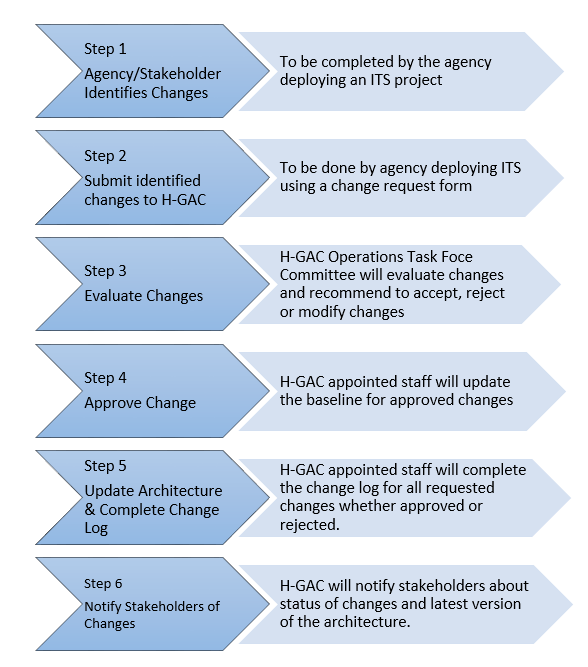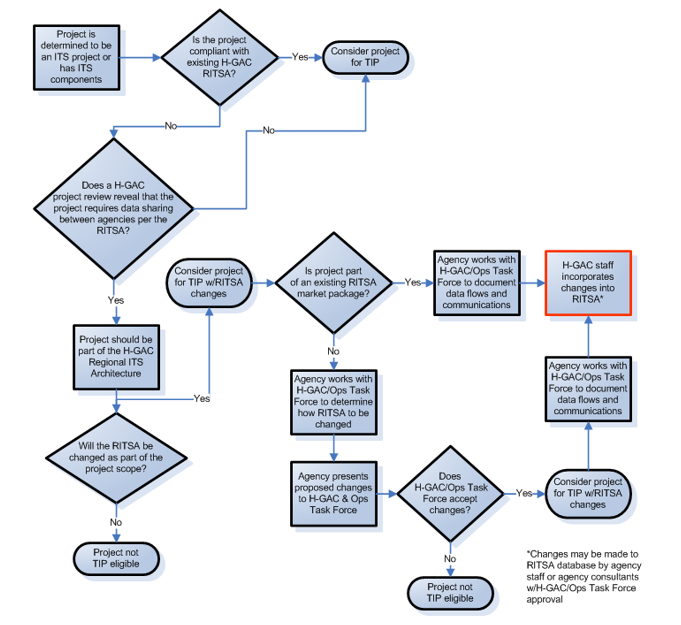Change Management Process
HGAC expects this website to be a living document and HGAC expects stakeholders to provide input and suggestions for minor changes, including the contents of the website, and updates to the RITSA necessary to accommodate initiatives and projects in the region, such as:
- TSMO Planning Components
- ITS Planning Components
- Systems Engineering Process
- Document and Project Archive (including the regional fiber map)
- The RITSA
Stakeholders can suggest any changes to the website under two scenarios:
- 1) General TSMO/ITS website content and revisions/updates.
- 2) Formal changes to the RITSA.
General TSMO/ITS Website Content and Revisions/Updates
Stakeholders can help HGAC maintain this living document by suggesting changes to any website content as well as provide any new (or newly discovered) documents and projects. Adding to the document and project database will help all stakeholders in the region and keep a single reference repository for TSMO and ITS. These type of changes can be requested/suggested through the General Website Change and Update Form. Once HGAC receives the form, it will be placed on the HGAC Operations Task Force Agenda and discussed at the next meeting where an HGAC official or the Task Force will 1) accept, 2) deny, or 3) request more information. HGAC will maintain a website change log that will include the initial form and any meeting minutes even if the request is denied.
Formal Changes to the RITSA
In those cases when a formal change to the RITSA is required, an ITS Architecture Maintenance Documentation Form is used to document the modification. Stakeholders should complete this form.
- 1) Whenever a new ITS project is completed so that status changes can be reflected (e.g., planned data flows are now existing) in an “as-built” architecture.
- 2) When a modification to the RITSA is proposed.
The stakeholder that proposes the change should coordinate with any other stakeholder agency potentially impacted. Stakeholders should document this coordination in the RITSA change form simplifying the change management process. Once HGAC receives the form, HGAC will place the change request on the HGAC Operations Task Force Agenda and stakeholders will discuss the change at the next meeting, where and HGAC official or the Task Force will 1) accept, 2) deny, or 3) request more information about the proposed modifications to the architecture.
The process for changing the baseline regional ITS architecture is shown in more detail below.

Step 1 – Agency/Stakeholder Identifies Changes
- Agency staff determines whether a project is adequately represented in the current version of the architecture (by examining the existing RITSA database). This step is done prior to completing the form.
- If agency staff finds that the project is mapped correctly in the existing architecture, no changes are necessary, and the agency submits the ITS Architecture Maintenance Documentation Form indicating compliance to HGAC. The completed form is posted to the RITSA website.
- If changes are necessary, agency staff completes the ITS Architecture Maintenance Documentation Form and submits to HGAC.
Step 2 – Agency/Stakeholder Submits Changes to HGAC and Operations Task Force
Step 3 – Evaluate Changes
- HGAC staff may independently evaluate the changes or require the agency to provide an evaluation.
- If the change impacts other stakeholders, HGAC may include them in the evaluation process.
Step 4 – Approve Changes
- Changes may be accepted, denied, or deferred for more information.
- Changes are made by HGAC staff and Operations Task Force consensus – unanimous consent is not required. The flowchart below shows how changes fit in with the TIP process.
Step 5 – Update Architecture and Complete Change Log
- Changes made to architecture database and other documentation as required for periodic or exception updates.
Step 6 – Notify Stakeholders of Changes
- Contact lists updated of stakeholders listed in the architecture.
- Announcements of new versions of the RITSA database and/or documentation sent out as needed and current RAD-IT file posted on the website.

Stakeholder Effort Required
To identify the changes to the architecture needed for a given ITS project, agencies will need a staff member (or consultant) skilled with the use of RAD-IT. Depending upon the skill level of the responsible person, size of the project, and number of modifications needed for compliance, the architecture evaluation and change request form submission could be completed within a matter of days.
Evaluating changes to the architecture database may be more time consuming process. All stakeholders affected by proposed changes will be informed about the changes and asked to provide their approval or objections. Task Force Committee will then consider the proposed changes along with any objections raised by affected stakeholders during the evaluation process. Based on the nature of proposed changes and approval/objections from affected stakeholders, the evaluation process could be completed in one meeting or may require several meetings.
Once the changes have been accepted or denied, HGAC staff responsible for maintenance of the RAD-IT database can incorporate changes to the file (or require that an agency do so), complete the change log form, and inform stakeholders about the new version of architecture file in a few days.
The best advice to stakeholder agencies is to start working with HGAC staff early in the ITS project development process. Whether or not your project is subject to detailed systems engineering or substantive changes to the ITS architecture can be determined early on in the process so that no surprises come up late in the planning and/or design stages of a project. Agencies should also remember the “as-built” part of their ITS project and the RITSA – there is a responsibility to confirm that the project remains consistent with the architecture after the project is complete and data is flowing.
 Houston-Galveston Area Council Transportation Systems Management & Operations Clearinghouse
Houston-Galveston Area Council Transportation Systems Management & Operations Clearinghouse

